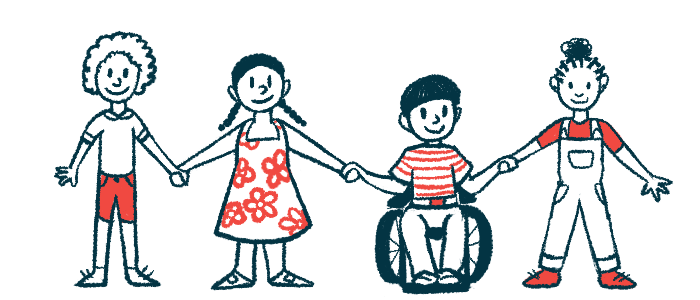FKBP14 Gene Mutations Lead to Collagen Protein Buildup in kEDS
Case series outlines clinical signs of kyphoscoliotic EDS in 3 patients

Mutations in the FKBP14 gene, a cause of kyphoscoliotic Ehlers-Danlos syndrome (kEDS), lead to the accumulation of collagen protein within connective tissue cells, a case series reported.
Typically, collagen is secreted from these cells to add strength, support, and stretchiness to organs and tissues. In kEDS, it instead is retained, and results in “significant intracellular accumulation,” affecting vascular and muscle tissue, according to the researchers.
The team here described the clinical signs and symptoms of three kEDS patients, characterized by kyphoscoliosis — a hunched back, called kyphosis, combined with a sideways curvature of the spine known as scoliosis.
“Our findings broaden the clinical and molecular spectrum of this disorder, and our functional studies possibly explain some of the clinical features in kEDS–FKBP14,” they wrote.
The case series, “Kyphoscoliotic Ehlers-Danlos syndrome caused by pathogenic variants in FKBP14: Further insights into the phenotypic spectrum and pathogenic mechanisms,” was published in the journal Human Mutation.
In addition to kyphoscoliosis, other kEDS symptoms included stretchy skin that easily bruises, low muscle tone (hypotonia) at birth, delayed motor development, abnormal gait, or walking ability, and visual impairment.
FKBP14 gene in kEDS
The condition is caused by mutations in the PLOD1 gene, and in rarer cases, in the FKBP14 gene. That gene provides instructions for an enzyme called FKBP prolyl isomerase 14, known as FKBP22. The enzyme, called a chaperone, assists with the folding of collagen proteins, which is essential for their function in connective tissue.
While FKBP14 gene mutations are known to result in a deficiency of FKBP22, information on the molecular consequences of the lack of this protein is limited.
Now, researchers based at Ghent University, in Belgium, along with collaborators in Iran, India, and Lithuania, described the clinical manifestations of three unrelated individuals with kEDS-FKBP14 and provided details of associated molecular defects.
The first patient, a girl age 7 at the time of the report, was born to unrelated Indian parents, and had hypotonia and dislocation of the left hip at birth. She was able to walk independently by the time she was 2. Clinical examinations at the ages of 18 months and seven years revealed the presence of kyphoscoliosis, joint hypermobility, soft and mildly stretchy skin with several scars, and vision impairment.
The second patient, a Lithuanian girl born to unrelated parents, at birth had severe hypotonia and a cleft palate. Progressive kyphoscoliosis became apparent at 3 months, and she could walk without support after 2 years. Among the symptoms revealed in a clinical examination, done at age 8, were severe kyphoscoliosis, joint hypermobility, recurrent shoulder dislocations, and muscle hypotonia. The girl also had stretchy skin with scars, vision impairment, and heart abnormalities.
Patient three was the only daughter of related Iranian parents and had a hip dislocation and severe muscle hypotonia at birth. Delayed motor development was noted; she could walk independently by 4 years. At age 5, she was found to have progressive kyphoscoliosis, pronounced joint flexibility, flat feet, hernia, severe muscle hypotonia, and stretchy skin, though without scars. This child also had abnormally small cornea, the eye’s transparent, protective outer layer.
Genetic analysis revealed each patient carried a different FKBP14 gene mutation — one of which, c.587A>G, was previously unreported. Two sets of parents were unaffected carriers of FKBP14 defects, while the third set was not tested.
“This brings the total number of unique pathogenic [disease-causing] FKBP14 variants to eight,” the researchers wrote.
Skin fibroblasts, collagen-secreting cells that help form connective tissue, were collected from the first two patients. These cells showed a significant reduction in FKBP14 gene activity and confirmed lower levels of FKBP22 protein compared with control fibroblasts.
Within patients’ fibroblasts, a significant increase in two types of collagen — types III and VI — was detected, suggesting these collagen types were retained, and not secreted, from FKBP22-deficient cells, according to researchers.
Further experiments showed the accumulation of these collagen proteins within fibroblasts did not trigger the cellular response to degrade and dispose of unfolded proteins. Also, FKBP14 gene mutations did not appear to impact the activity of the PLOD1 gene.
Finally, because cell migration is required for wound repair, which is impaired in kEDS and leads to scar formation, the team measured the migration ability of patients’ fibroblasts. While no differences were noted between the first and second patients’ cells, there was a nonsignificant initial delay in their fibroblast migration compared with healthy fibroblasts.
“We present the clinical characteristics of three unrelated individuals with … pathogenic variants in FKBP14,” the team wrote.
“Consistent clinical features … are kyphoscoliosis, generalized joint hypermobility and muscle hypotonia, and we report microcornea in two individuals, a previously unreported clinical feature in kEDS–FKBP14,” they concluded.







